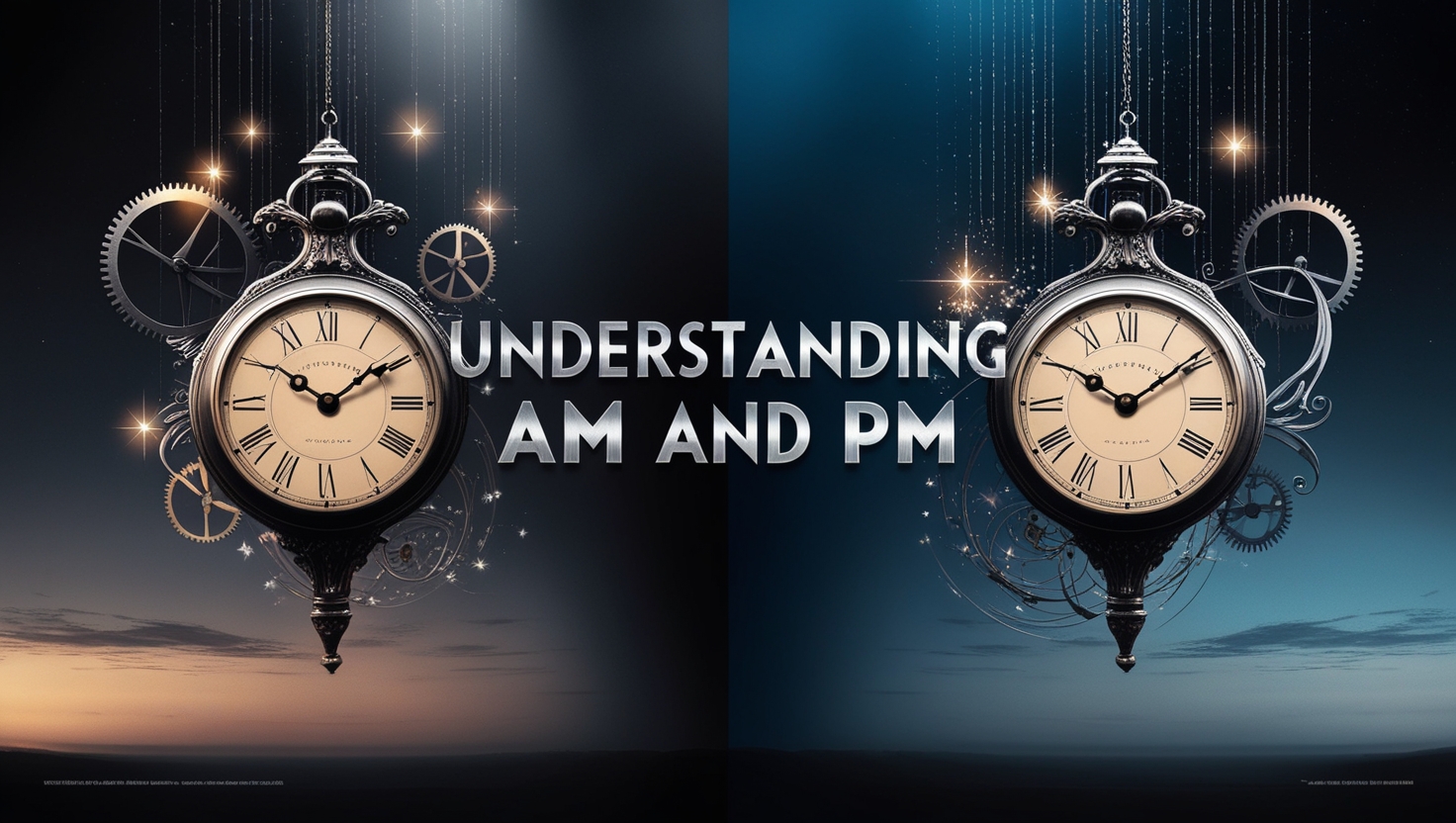Understanding AM and PM: Meaning, Origins, and Usage
Introduction
AM and PM Full Form and Their Meanings
The notations AM and PM are universally used to denote time in the 12-hour clock system. These two small abbreviations hold a significant place in everyday life, yet few people pause to consider their meaning, origins, and the reason for their usage. Whether you are waking up at 7:00 AM or scheduling a meeting for 2:00 PM, the abbreviations serve as a crucial part of our timekeeping system.
In this article, we will dive deep into what AM and PM stand for, their historical origins, and why they are essential in the context of timekeeping. We will also explore how AM and PM compare to the 24-hour clock system, commonly known as military time, and discuss their cultural relevance. By the end of this article, you will have a thorough understanding of these time notations and their importance in daily life.
What Do AM and PM Stand For?
The abbreviations AM and PM are derived from Latin, and they represent two distinct periods of the day. Here’s what they stand for:
- AM: The phrase Ante Meridiem means “before noon” or “before midday.”. “”.
- PM: Post Meridiem, which translates to “after midday” or “afternoon.”
In essence, AM refers to the hours between midnight and noon (00:00 to 11:59), while PM refers to the hours between noon and midnight (12:00 to 23:59). These abbreviations are used to differentiate between the two 12-hour periods that make up a full 24-hour day.
A Breakdown of the 12-Hour Cycle
To better understand AM and PM, it’s helpful to break down the 12-hour time cycle they represent:
- AM (Ante Meridiem): Midnight (12:00 AM) marks the beginning of the day. The hours from midnight to 11:59 AM are referred to as the morning hours. This includes everything from the early hours of 1:00 AM to the late morning at 11:59 AM.
- PM (Post Meridiem): Noon (12:00 PM) marks the beginning of the afternoon. The hours from 12:00 PM to 11:59 PM are considered the afternoon, evening, and night. This period includes mid-afternoon hours like 3:00 PM and evening hours like 8:00 PM.
Historical Origins of AM and PM
The usage of AM and PM can be traced back to ancient civilizations that were keen on understanding and dividing time according to the movement of the sun. Early societies like the Egyptians and Babylonians developed sun dials and water clocks to measure time during daylight hours, but it wasn’t until the Romans that a more structured system of timekeeping emerged.
The Influence of Ancient Rome
The Romans were instrumental in dividing the day into two distinct halves. Their timekeeping system was heavily influenced by the natural cycle of daylight and darkness. The Roman day began at midnight and was divided into 12-hour periods based on the movement of the sun.
It is from Latin, the language of the Romans, that the terms Ante Meridiem and Post Meridiem originated. Meridiem translates to “midday” or “noon,” and the prefixes “ante” and “post” indicate “before” and “after,” respectively. Thus, the designations of AM and PM came into common usage, marking the distinction between the hours before and after noon.
The Evolution of the 12-Hour Clock
The modern 12-hour clock system, which includes the use of AM and PM, evolved from these early Roman practices. It was a practical way to measure time because humans naturally follow a diurnal cycle of day and night, influenced by sunlight. While the 24-hour clock system has gained prominence in certain sectors (like military and aviation), the 12-hour system remains popular in everyday life, especially in English-speaking countries.
Why Do We Use AM and PM?
One may wonder why society uses the 12-hour clock system with AM and PM rather than the 24-hour clock system, which eliminates any ambiguity between morning and evening hours. The answer lies in tradition, ease of use, and cultural preference.
Simplicity and Familiarity
For most people, the 12-hour clock is simpler and more intuitive. Splitting the day into two 12-hour segments feels more natural, especially for those accustomed to thinking in terms of mornings and afternoons. Instead of calculating whether 18:00 means 6:00 PM, people are more comfortable seeing the time directly divided into AM (morning) and PM (afternoon and evening).
The simplicity of AM and PM helps avoid confusion in casual communication. For instance, scheduling a meeting at 2:00 PM is more straightforward for the average person than using the 24-hour equivalent (14:00). This intuitive time format has been engrained in our daily lives for centuries.
Cultural Preferences
Different countries use different systems of timekeeping. While the 24-hour clock (or military time) is popular in Europe and various parts of the world, the 12-hour clock remains widely used in North America, the United Kingdom, and several Commonwealth countries.
The continued use of AM and PM is largely cultural, passed down from generation to generation. In countries where the 12-hour system is dominant, children learn to tell time using AM and PM from a young age, making the system deeply ingrained in daily life.
The 12-Hour Clock vs. The 24-Hour Clock
Understanding the 24-Hour Clock
In contrast to the 12-hour clock, the 24-hour clock system does not use AM and PM to differentiate between morning and afternoon. Instead, it counts the hours of the day from 00:00 to 23:59, with no need to specify whether the time is in the morning or afternoon.
For example:
- 00:00 is midnight
- 12:00 is noon
- 15:00 is 3:00 PM
- 20:00 is 8:00 PM
The 24-hour clock system is considered more precise because it eliminates any ambiguity that might arise from the use of AM and PM. For example, if someone says “Meet me at 7:00,” it’s not always clear whether they mean AM or PM unless specified. In the 24-hour clock system, this confusion is avoided: 07:00 is morning, and 19:00 is evening.
Common Uses of the 24-Hour Clock
While AM and PM dominate casual conversation and everyday life, the 24-hour clock is often preferred in certain professional sectors where clarity and precision are essential.
- Military Time: The military exclusively uses the 24-hour clock to ensure no confusion during operations. Whether it’s coordinating troop movements or issuing orders, the 24-hour system eliminates the possibility of mixing up AM and PM.
- Aviation: Airports, airlines, and aviation professionals use the 24-hour clock to ensure consistency across different time zones and avoid errors in flight scheduling.
- Healthcare: Hospitals and emergency services often use the 24-hour clock for precise record-keeping, ensuring there is no ambiguity about when medications are administered or when events occur.
Cultural Significance of AM and PM
While AM and PM may seem like simple designations, they hold significant cultural value in countries where the 12-hour system is prevalent. The two abbreviations play a role in shaping how people understand and relate to time.
Morning Routines and AM
For many, the hours of AM are associated with routines and productivity. The morning is a time for getting ready for work, school, or daily activities. People schedule their mornings based on AM time slots, whether it’s waking up at 6:00 AM, eating breakfast by 8:00 AM, or commuting to work by 9:00 AM. The term “AM” thus becomes a marker for the early part of the day, often filled with preparation and anticipation.
PM and Leisure
On the other hand, PM is associated with the latter part of the day. From lunch at noon (12:00 PM) to relaxation in the evening (8:00 PM), the hours of PM often signify winding down or socializing. The transition from work to leisure, afternoon breaks, and evening entertainment are all tied to the concept of PM.
Conclusion
The abbreviations AM and PM may seem small and simple, but they are an integral part of how we perceive and manage time. Derived from Latin, these abbreviations serve to divide the day into two halves, distinguishing the morning from the afternoon and evening. While the 24-hour clock offers precision and clarity, AM and PM remain a popular and intuitive system for most people, especially in North America and other parts of the English-speaking world.
Whether you’re scheduling a meeting, setting your alarm, or enjoying a quiet evening, AM and PM help organize your day and give structure to your time. From their historical roots in Roman civilization to their modern usage in daily life, AM and PM continue to play a fundamental role in how we navigate the passing hours.
If you Liked Reading our Blog Read More Blogs Here and Below is the Link to our WhatsApp channel Join it for the Latest Post Updates. (Read For WhatsApp Channel Privacy and Security Here).
UseFull Resources:
| Resources | Resources |
|---|---|
| Tooldar: Tooldar | Hemingway Editor: Hemingway Editor |
| Ilovepdf3: Ilovepdf3 | Grammarly: Grammarly |
| Adorepdf: Adorepdf | Coursera: Coursera |
| Custom Design Agency: Articon Design Agency | Udemy: Udemy |
| Google: Google | Khan Academy: Khan Academy |
| Yandex: Yandex | Wolfram Alpha: Wolfram Alpha |
| Baidu: Baidu | TED Talks: TED Talks |
| Medium: Medium | Skillshare: Skillshare |
| Quora: Quora | Canva: Canva |
| Duolingo: Duolingo | Figma: Figma |
| Nerdfitness: Nerdfitness | Trello: Trello |
| DeepL: DeepL | Notion: Notion |
| LinkedIn: LinkedIn | Asana: Asana |
| Stack Overflow: Stack Overflow | Mailchimp: Mailchimp |
| GitHub: GitHub | Zapier: Zapier |
Note : These Above Resources Are just for Educational and ease of use Purposes we neither Endorse them, they were working at the time of sharing.
.Disclaimer: The information presented in this blog is for educational and informational purposes only and should not be considered financial, Political, or cultural advice. All efforts have been made to ensure the accuracy of the content at the time of writing.
Think We Missed Something?
If you notice an error or have a suggestion, we encourage you to submit a correction. Help us keep our information up-to-date and reliable!











